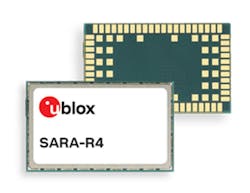LPWA Cellular Modules Gain Security, Integrated GNSS Positioning Features
The SARA-R4 family of LTE-M/NB-IoT and EGPRS cellular modules from u-blox now includes variants with the hardware and software features necessary to enable end-to-end security and services for Internet of Things (IoT) data, devices, and ecosystems. With their enhanced security protection, industrial output power to grant best coverage even in weak signal conditions, and everywhere location using the company’s GNSS technology, these modules deliver valuable functionalities tailored specifically to the LPWA IoT market.
The SARA-R4 series is well-suited for a wide range of mission-critical IoT applications such as connected healthcare, industrial monitoring, point-of-sale and vending terminals, and tracking and telematics devices, as well as smart-lighting solutions and building automation. They’re especially useful in narrowband IoT (NB-IoT) applications that don’t require high data rates or low latencies. Small amounts of data are sent in such applications, where long battery life is important.
Security features include a unique and immutable root of trust (RoT) for each device, as well as access to a scalable pre-shared key (PSK) management system. This provides the foundation for a solid set of advanced security functionalities to enable data encryption and decryption, both on‑device as well as from‑device‑to‑cloud. The choice of PSK-based security, rather than the more complex and computationally intensive public-key-infrastructure (PKI) approach, strikes the right balance between implementation costs and level of security protection for many IoT applications.
All SARA-R422 modules provide 23 dBm of output power, which is aligned to the standard LTW power class, as opposed to the 20-dBm output sometimes seen in cellular modules. As a result, the end device will properly operate in all network conditions.
In good coverage areas, the beefed-up power output is of little consequence, But it’s in weak coverage areas that it makes a difference: It means no issues at cell edges, no coverage issues in weak signal conditions, and, even more importantly, no unwanted continual pinging of the network that shortens battery life by increasing transmit time and overall system power consumption. Moreover, thanks to the 23-dBm output, users can relax antenna specifications somewhat, making it easier for them to integrate the module into end devices.
The SARA-R422M8S comes pre-integrated with the u-blox M8 Global Navigation Satellite System (GNSS) receiver and a separate GNSS antenna interface. This provides highly reliable, accurate positioning data simultaneously with LTE communications. The module also supports hybrid positioning strategies, in which positioning data provided by satellite constellations is enhanced with data from u-blox’s CellLocate service, ensuring that location data is always available everywhere.
In addition, the modules are designed for long working lifetimes in the field. To that end, they include support for LWM2M, a lightweight machine-to-machine communications protocol ideal for IoT applications. It offers the possibility of updating the firmware of modules already in the field over the air through the company’s Firmware Over The Air (uFOTA) client/server firmware service.
The new SARA-R422 cellular modules will be available in the second half of 2020.
About the Author
David Maliniak
Executive Editor, Microwaves & RF
I am Executive Editor of Microwaves & RF, an all-digital publication that broadly covers all aspects of wireless communications. More particularly, we're keeping a close eye on technologies in the consumer-oriented 5G, 6G, IoT, M2M, and V2X markets, in which much of the wireless market's growth will occur in this decade and beyond. I work with a great team of editors to provide engineers, developers, and technical managers with interesting and useful articles and videos on a regular basis. Check out our free newsletters to see the latest content.
You can send press releases for new products for possible coverage on the website. I am also interested in receiving contributed articles for publishing on our website. Use our contributor's packet, in which you'll find an article template and lots more useful information on how to properly prepare content for us, and send to me along with a signed release form.
About me:
In his long career in the B2B electronics-industry media, David Maliniak has held editorial roles as both generalist and specialist. As Components Editor and, later, as Editor in Chief of EE Product News, David gained breadth of experience in covering the industry at large. In serving as EDA/Test and Measurement Technology Editor at Electronic Design, he developed deep insight into those complex areas of technology. Most recently, David worked in technical marketing communications at Teledyne LeCroy, leaving to rejoin the EOEM B2B publishing world in January 2020. David earned a B.A. in journalism at New York University.


